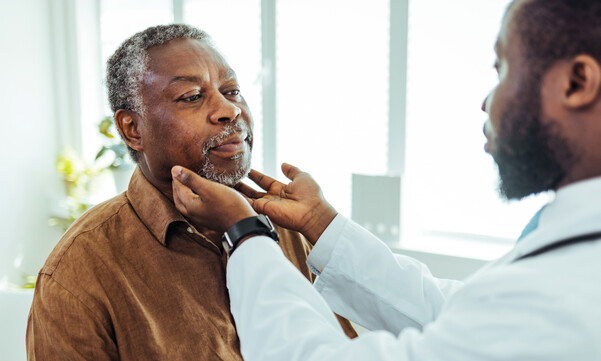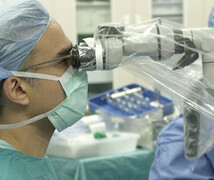Severe vertigo forced 60-year-old Beth Huber to stop driving, start walking with a cane, and take medical leave from her professorship. When treatments failed to help, she turned to Duke Health neurotologist Eric Formeister, MD. He discovered Huber had a rare condition called superior canal dehiscence syndrome (SCDS) and performed complex surgery to treat it. Now Huber is back to driving, working, and more. “I wasn’t really living before,” Huber said. “I feel like Dr. Formeister saved my life.”
Vertigo Leads to ER Visit
Beth Huber of Asheville, NC remembers grading papers in January 2020 when she suddenly felt extremely dizzy and off balance. “My world turned upside down, and everything went topsy-turvy.” Her daughter called an ambulance, and Huber woke up at her local emergency room. After spending a few days in the hospital, she headed home, but the dizziness lingered. “It felt like I was constantly on a boat,” she said.
A Parade of Doctors, But No Relief
Huber searched for help over the next three years. “I went to so many doctors who said, ‘Oh, I got this.' But they didn’t. It just kept getting worse,” Huber recalled. She tried medications, physical therapy, steroid injections, and positioning maneuvers, but nothing worked.
During that time, Huber transitioned her college courses online instead of teaching in person because she couldn’t stand for very long. She started walking with a cane and propping herself up when she sat down so she didn’t just fall over. She stopped driving and considered taking early retirement.
“I felt like a non-functioning human,” she said. “Finally, I had a doctor who said, ‘I'm out of ideas. Let's send you to Duke.’ That’s where I met Dr. Formeister.”
Small Clue Leads to Correct Diagnosis
Dr. Formeister specializes in treating complex inner-ear problems and balance disorders. Right away, he started Huber on a new medication, ordered some basic tests, and got to work digging through her medical history and imaging scans. “Dizziness diagnoses are diagnoses of exclusion, so you have to do your due diligence and a thorough investigative workup to be able to rule out certain things,” Dr. Formeister said. As he was reviewing a previous MRI, an abnormality in her right ear caught his attention, so he ordered a CT scan to get a better look. He turned out to be right -- the scan showed a small area of missing bone between Huber’s inner ear and cranial cavity. A specialized hearing test measuring how well she could hear bone-conducted sound confirmed Dr. Formeister’s suspicions.
“Dr. Formeister asked me, ‘Can you hear your heartbeat in your ear?’ and ‘Do you hear your voice really loud in your head?’” Beth recalls. “And I said, ‘Yes, but doesn't everybody?’” She was surprised to learn the answer was no.
Dr. Formeister diagnosed Huber with superior canal dehiscence syndrome (SCDS), a rare condition characterized by unusual hearing and balance symptoms, including amplified hearing of your own voice or body sounds, dizziness triggered by loud noises, and instability. Dr. Formeister and his radiology colleagues also discovered evidence of a small brainstem stroke in her recent past, as well as balance and hearing loss on her right side.
“He explained everything that was happening to me, and suddenly it all made sense,” Huber said. “All of those symptoms that I didn't even think were symptoms started to become clear."
A Path Forward to Surgery
Dr. Formeister explained that canal dehiscence repair surgery could close the abnormal opening in her inner ear and the symptoms caused by it, but he couldn’t guarantee the procedure would improve her tilting sensation or general sense of imbalance. Dr. Formeister would access the area through the mastoid bone behind her ear. Huber spent time researching the procedure, including the risks and benefits. After talking again with Dr. Formeister about exactly what to expect, Huber decided to proceed with surgery.
Dr. Formeister performed the surgery on August 28, 2023. Huber noticed a huge improvement immediately afterward. “When I opened my eyes in the recovery room, it was like I was in a different head. It was amazing,” Huber said. “Everything was completely different.” She no longer felt like she was on a boat. She could look at her family without feeling like they were moving. “I remember in the first couple of weeks after the surgery just feeling hugely encompassing relief.”
Getting Back to Living
Several months later, Huber is back to doing almost everything she’d given up. Because of her prior brainstem stroke, she continues to experience a slight occipital tilt -- feeling like her vision is tilted to one side -- but she manages it easily now that the internal noise and vertigo are gone.
“It has been a celebration ever since the surgery. I don't have to grab my little cane. I walk to my car and to the mailbox. I drive to work. Life is good,” Huber said. “I'm so grateful to Dr. Formeister, to Duke. Now I tell everyone if you want the best care, head towards Durham."
Dr. Formeister said he’s grateful, too. “I'm so glad I was able to help her. She is a wonderful person, and she's got a lot of life left to live.”




